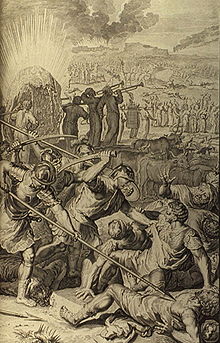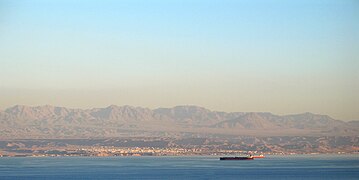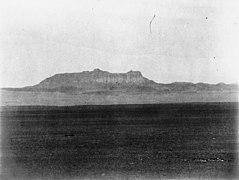Midian
Midian
| |
|---|---|
 | |
 |
Midian(/ˈmɪdiən/;Hebrew:מִדְיָןMīḏyān;Arabic:مَدْيَن,romanized:Madyan;Greek:Μαδιάμ,Madiam;[a]Taymanitic:𐪃𐪕𐪚𐪌MDYN) is a geographical region inWest Asiamentioned in theTanakhandQuran.William G. Deverstates that biblical Midian was in the "northwestArabian Peninsula,on the east shore of theGulf of Aqabaon theRed Sea",[1]an area which contained at least 14 inhabited sites during theLate Bronzeandearly Iron Ages.[2][3]
According to theBook of Genesis,theMidianiteswere the descendants ofMidian,a son ofAbrahamand his wifeKeturah:"Abraham took a wife, and her name was Keturah. And she bare him Zimran, and Jokshan, and Medan, and Midian, and Ishbak, and Shuah" (Genesis25:1–2,King James Version).[4]
Traditionally, knowledge about Midian and the Midianites' existence was based solely upon Biblical and classical sources,[5]but in 2010 a reference to Midian was identified in aTaymaniticinscription dated to before the 9th century BC.[6]
Land or tribal league?[edit]
Some scholars have suggested that the name "Midian" does not refer to geographic places or to a specific tribe,[7][8]but to a confederation or "league" of tribes brought together as a collective for worship purposes.Paul Hauptfirst made this suggestion in 1909,[9]describing Midian as a "cultic collective" (German:Kultgenossenschaft) or anamphictyony,meaning "an association (German:Bund) of different tribes in the vicinity of asanctuary".Elath,on the northern tip of theGulf of Aqabawas suggested[by whom?]as the location of the firstshrine,with a second sanctuary located atKadesh.[citation needed]
Later writers have questioned the identified sanctuary locations but supported the thesis of a Midianite league.George Mendenhallsuggests that the Midianites were a non-Semiticconfederate group,[10]andWilliam Dumbrellmaintains the same:
We believe that Haupt's proposal is to be adopted, and that Midian, rather than depicting a land, is a general term for an amorphous league of theLate Bronze Age,of wide geographical range, who, after a series of reverses, the most prominent of which are recorded inJudges 6–7,largely disappeared from the historical scene...[11]
Metallurgy[edit]
The area ofTimna valleycontains large deposits of copper that had been mined from the prehistoric times onward. Copper was mined here by the Egyptians during the reign of PharaohSeti Iat the end of the 14th century BCE.[12]
Religion[edit]
It is uncertain which deities the Midianites worshipped. Through their apparent religio-political connection with theMoabites[13]they are thought to haveworshipped a multitude,includingBaal-peorandAshteroth.According toKarel van der Toorn,"By the 14th century BC, groups of Edomites and Midianites worshippedYahwehas their God; "this conclusion is based on identification between Midianites and theShasu.[14]
The Midianite connections to metallurgy at Timna have been noted by many scholars. Large amounts of Midianite ceramic ware has been discovered at these mining sites.[15]
An Egyptian temple ofHathorat Timna (Site 200) was first discovered during theBeno Rothenberg's excavations.[16]
- "Rothenberg’s excavation of Site 200 revealed a number of Egyptian hieroglyphic inscriptions including those of: Seti I, Ramesses II, Merneptah, Seti II, and Queen Twosret of the Nineteenth Dynasty, as well as Ramesses III, Ramesses IV, and Ramesses V of the Twentieth Dynasty (pp. 163–166)."[17]
The site also continued to be used during the Midianite occupation in the area, which is usually dated to terminal Late Bronze Age-Early Iron Age.
The Midianites transformed the Hathor mining temple into a desert tent-shrine.[18]In addition to the discovery of post-holes, large quantities of red and yellow decayed cloth with beads woven into it, along with numerous copper rings/wire used to suspend the curtains, were found all along two walls of the shrine.
Beno Rothenberg,[19]the excavator of the site, suggested that the Midianites were making offerings to Hathor, especially since a large number of Midianite votive vessels (25%) were discovered in the shrine. However, whether Hathor or some other deity was the object of devotion during this period is difficult to ascertain.
A small bronze snake with gilded head was also discovered in thenaosof the Timna mining shrine, along with a hoard of metal objects that included a small bronze figurine of a bearded male god, which according to Rothenberg was Midianite in origin. Michael Homan observes that the Midianite tent-shrine at Timna is one of the closest parallels to the biblicalTabernacle.[20]
In religious scripture[edit]
In the Bible[edit]

Midian was the son ofAbraham.[21]Abraham's great-grandsonJoseph,after being thrown into a pit by his brothers, was sold to either Midianites orIshmaelites.[22]
Mosesspent 40 years in voluntary exile in Midian after killing an Egyptian.[23]There, he marriedZipporah,the daughter of Midianite priestJethro[24](also known asReuel). Jethro advised Moses on establishing a system of delegated legal decision-making.[25]Moses askedHobab,the son of Reuel, to accompany the Israelites travelling towards thePromised Landbecause of his local knowledge, but Hobab preferred to return to his homeland.[26]A number of scholars have proposed that the biblical description of devouring fire on Mount Sinai refers to an erupting volcano in the land of biblical Midian identified asHala-'l Badrin northwesternSaudi Arabia.[27]
During theBaal-Peor episode,when Moabite women seduced Israelite men,Zimri,the son of aSimeonitechief, got involved with a Midianite woman calledCozbi.The couple were speared byPhinehas.[28]War against Midian followed.Numbers 31reports that all but the virgin females were slain and their cities burned to the ground.[29]Some commentators, for example thePulpit CommentaryandGill'sExposition of the Bible,note that God's command focused on attacking the Midianites and not the Moabites,[30]and similarly Moses inDeuteronomydirected that the Israelites should not harass the Moabites.[31]A modern-day movement, thePhineas Priesthood,has interpreted this story as a prohibition againstmiscegenation,despite the Midianites being closely related to the Israelites as descendants of Abraham, and Moses being married to a Midianite.
During the time of theJudges,Israel was oppressed by Midian for seven years[32]untilGideondefeated Midian's armies.[33]Isaiahspeaks of camels from Midian andEphahcoming to "cover your land", along with the gold and frankincense fromSheba.[34]This passage, taken by theGospel of Matthewas a foreshadowing of theMagi's gifts to the infantJesus,has been incorporated into theChristmasliturgy.[citation needed]
In the Quran[edit]
The people of Midian are mentioned extensively in theQuran.The word 'Madyan' appears 10 times in it. The people are also calledʾaṣḥabu l-ʾaykah(Arabic:أَصْحَابُ ٱلْأَيْكَة,lit. 'Companions of the Wood').[35][36][37][38]The lands of Midian are mentioned in suraAl-Qasas(The Stories), verses 20–28, of the Quran as the place where Moses escaped upon learning of the chiefs conspiring to kill him.[39]
Surah 9 (Al-Tawbah), verse 70 says "Has not the story reached them of those before them? – The people of Nūḥ (Noah),ʿĀdandThamud,the people of Ibrahim (Abraham), the dwellers [literally, comrades] of Madyan (Midian) and the cities overthrown [i.e. the people to whom Lūt (Lot) preached], to them came their Messengers with clear proofs. So it was notAllahwho wronged them, but they used to wrong themselves. "[40]
In Surah 7 (Al-ʾAʿrāf), Madyan is mentioned as one of several peoples who were warned by prophets to repent lest judgment fall on them. The story of Madyan is the last, coming after that ofLotpreaching to his people (referring to the destruction of theCities of the Plain). Madyan was warned by the prophetShuʿaibto repent of practicing polytheism, using false weights and measures and lying in wait along the road. But they rejected Shuʿayb, and consequently were destroyed by a tremor (rajfa,v. 91).Abdullah Yusuf Aliin his commentary (1934) writes, "The fate of the Madyan people is described in the same terms as that of the Thamūd in verse 78 above. An earthquake seized them by night, and they were buried in their own homes, no longer to vex Allah's earth. But a supplementary detail is mentioned in [Quran] 26:189, 'the punishment of a day of overshadowing gloom,' which may be understood to mean a shower of ashes and cinders accompanying a volcanic eruption. Thus a day of terror drove them into their homes, and the earthquake finished them."[41]Excavations at the oasis ofAl-Bad',identified as the city of Midian mentioned in classical and Islamic sources, have uncovered evidence of an occupation spanning from the 4th millennium BC.[42][43]
Pottery[edit]
Midianite pottery,also called Qurayyah Painted Ware (QPW), is found at numerous sites stretching from the southernLevantto NW Saudi Arabia, theHejaz;Qurayyah in NW Saudi Arabia is thought to be its original location of manufacture.[44]The pottery is bichrome / polychrome style and it dates as early as the 13th century BC; its many geometric, human, and animal motifs are painted in browns and dark reds on a pinkish-tan slip. "Midianite" pottery is found in its largest quantities at metallurgical sites in the southern Levant, especially Timna.[45]Because of theMycenaeanmotifs on Midianite pottery, some scholars including George Mendenhall,[46]Peter Parr,[47]andBeno Rothenberg[48]have suggested that the Midianites were originallySea Peopleswho migrated from theAegeanregion and imposed themselves on a pre-existing Semitic stratum. The question of the origin of the Midianites still remains open.[citation needed]
Midian Mountains[edit]
| Midian Mountains | |
|---|---|
 Jabal Ḥubaysh (Arabic:جَبَل حُبَيْش) | |
| Naming | |
| Native name | جِبَال مَدْيَن(Arabic) |
| Geography | |
| Country | |
| Region | Tabuk(KSA) 'Aqabah(Jordan) Middle East |
| Range coordinates | 28°18′N35°36′E/ 28.3°N 35.6°E |
The Midian Mountains (Arabic:جِبَال مَدْيَن,romanized:Jibāl Madyan) are amountain rangein northwesternSaudi Arabia.They are considered to be either contiguous with theHijaz Mountainsto the south,[49]or a part of them.[50]The Hijaz are treated as part of theSarawat range,sensu lato.[51][52]
-
Haqlon the coast of theGulf of Aqababetween theSyrian regionandArabianandSinai Peninsulas,with the mountains in the background
See also[edit]
- ʿĀd
- Balak
- Al-Bad'
- Ishmaelites
- Kedar
- History of ancient Israel and Judah
- The Bible and history
- Midian war
- Sodom and Gomorrah
- Abarim,Jordanianmountains to the north
- Biblical Mount Sinai
Notes[edit]
- ^AlsoΜαδιανίτηςfor "Midianite".
References[edit]
- ^Dever, W. G.(2006),Who Were the Early Israelites and Where Did They Come From?,William B. Eerdmans Publishing Co.,p. 34,ISBN978-0-8028-4416-3
- ^Graf 2016,p. 428.
- ^Luciani, Marta (November–December 2023)."Archaeology in the Land of Midian: Excavating the Qurayyah Oasis".Biblical Archaeology Review.49(4).
- ^"Genesis 25:1–2".Bible Gateway.King James Version.
- ^Bryce, Trevor(2009).The Routledge Handbook of the Peoples and Places of Ancient Western Asia: From the Early Bronze Age to the Fall of the Persian Empire.London,United Kingdom:Routledge.p. 472.ISBN978-0-415-39485-7.
- ^Robin, Christian; Al-Ghabban, Ali (2017)."Une première mention de Madyan dans un texte épigraphique d'Arabie".Comptes rendus des séances de l'Académie des Inscriptions et Belles-Lettres(in French).161(1): 363–396.doi:10.3406/crai.2017.96407.S2CID246891828.
- ^William J. Dumbrell, Midian: A Land or a League?,Vetus Testamentum,Vol. 25, Fasc. 2, No. 2a. Jubilee Number (May, 1975), pp. 323–37
- ^Bromiley Geoffrey W.TheInternational Standard Bible Encyclopedia.Wm. B. Eerdmans, 1996.ISBN978-0-8028-3783-7.p. 350.
- ^Haupt, Paul (1909)."Midian und Sinai"[Midian and Sinai].Zeitschrift der Deutschen Morgenländischen Gesellschaft(in German).63:56. Archived fromthe originalon 2015-12-17.Retrieved1 August2015;quoted in Dumbrell
- ^"The Incident at Beth Baal Peor",The Tenth Generation: The Origins of the Biblical Tradition,1973
- ^ William J. Dumbrell, Midian: A Land or a League?,Vetus Testamentum,Vol. 25, Fasc. 2, No. 2a. Jubilee Number (May, 1975), p. 32.
- ^Jacob Edward Dunn 2015,‘A Land Whose Stones Are Iron And From Whose Hills You May Mine Copper’: Metallurgy, Pottery, And The Midianite-Qenite Hypothesis.Thesis, University of Georgia. 129 pages
- ^Numbers 22:4, 7
- ^Toorn, Karel van der.Family Religion in Babylonia, Ugarit, and Israel: Continuity and Change in the Forms of Religious Life.Leiden:Brill Publishers.p. 283.
- ^Rothenberg, Beno. The Egyptian Mining Temple at Timna. Institute for Archaeo-Metallurgical Studies London: Thames and Hudson, 1988
- ^Rothenberg, Beno (1972).Timna: Valley of the Biblical Copper Mines.London:Thames and Hudson.
- ^Jacob Edward Dunn 2015,‘A Land Whose Stones Are Iron And From Whose Hills You May Mine Copper’: Metallurgy, Pottery, And The Midianite-Qenite Hypothesis.Thesis, University of Georgia. 129 pages. Note 200, page 54
- ^Avner, Uzi (2014)."Egyptian Timna – Reconsidered".In Tebes, Juan Manuel (ed.).Unearthing the Wilderness: Studies on the History and Archaeology of the Negev and Edom in the Iron Age.Peeters. pp. 103–162.ISBN978-90-429-2973-9.
- ^Rothenberg, Beno (1972).Timna: Valley of the Biblical Copper Mines.London:Thames and Hudson.
- ^Homan, Michael M. (2002). "To Your Tents, O Israel!: The Terminology, Function, Form, and Symbolism of the Tents in the Bible and the Ancient Near East".Culture and History of the Ancient Near East.12.Brill Publishers:118.
- ^Genesis 25:1–2
- ^Genesis 37:28
- ^Exodus 2:11–15
- ^Exodus 2:21
- ^Exodus 18
- ^Numbers 10:29–31
- ^Dunn, Jacob E. (2014)."A God of Volcanoes: Did Yahwism Take Root in Volcanic Ashes?".Journal for the Study of the Old Testament.38(4): 387–424.doi:10.1177/0309089214536484.ISSN0309-0892.
- ^Numbers 25:6–8, 14–15
- ^Numbers 25:17andNumbers 31
- ^"Pulpit Commentary and Gill's Exposition of the Bible".BibleHub.Retrieved1 July2015.
- ^Deuteronomy 2:9
- ^Judges 6:1–6
- ^Judges 6:7–9
- ^Isaiah 60:6
- ^Quran15:78-79
- ^Quran26:176-189
- ^Quran38:13-15
- ^Quran50:12-14
- ^"Surah Al-Qasas - 20-28".The Noble Quran.RetrievedMay 19,2021.
- ^"Muhammad Taqi-Ud-Din al-Halali and Muhammad Muhsin Khan's Translation".July 2009. Archived fromthe originalon October 4, 2023.
- ^Ali, Abdullah Yusuf.The Holy Quran – English Translation of the Meaning and Commentary.King Fahd Holy Qur-an Printing Complex.Retrieved4 March2017.
- ^Charloux, Guillaume; Ahmed Sahlah, Samer; Badaiwi, Waleed Ali (January 2021)."Madian revealed? Assessing the history and archaeology of the oasis of al-Badʿ in northwestern Arabia".Semitica et Classica.14:97–141.doi:10.1484/j.sec.5.129522.ISSN2031-5937.
- ^"Al-Badʿ - Archéologie - culture.fr".archeologie.culture.gouv.fr.Retrieved2023-10-27.
- ^B. Rothenberg and J.Glass, "The Midianite Pottery," inMidian, Moab, and Edom: The History and Archaeology of the Late Bronze and Iron Age Jordan and North-West Arabia,JSOT Supplement Series 24, ed. John F.A. Sawyer and David J.A. Clines (Sheffield: JSOT Press, 1983), pp. 65–124.
- ^Tebes, "Pottery Makers and Premodern Exchange in the Fringes of Egypt: An Approximation to the Distribution of Iron Age Midianite Pottery,"Buried History43 (2007), pp. 11–26.
- ^George Mendenhall, "Qurayya and the Midianites," inStudies in the History of Arabia,Vol. 3, ed. A. R. Al-Ansary (Riyadh: King Saud University), pp. 137–45
- ^Peter J. Parr, "Further Reflections on Late Second Millennium Settlement in North West Arabia," inRetrieving the Past: Essays on Archaeological Research and Methodology,ed. J. D. Seger (Winona Lake: Eisenbrauns, 1996), pp. 213–18.
- ^Rothenberg, "Egyptian Chariots, Midianites from Hijaz/ Midian (Northwest Arabia) and Amalekites from the Negev in the Timna Mines: Rock drawings in the Ancient Copper Mines of the Arabah – new aspects of the region's history II,"Institute for Archaeo-Metallurgical Studies,newsletter no. 23 (2003), p. 12.
- ^Ghazanfar, Shahina A.;Fisher, Martin (2013-04-17). "4".Vegetation of the Arabian Peninsula.Sultan Qaboos University,Muscat,Oman:Springer Science+Business Media.pp. 71–94.ISBN978-9-4017-3637-4.
- ^Scoville, Sheila A. (2006). "3".Gazetteer of Arabia: a geographical and tribal history of the Arabian Peninsula.Vol. 2. Akademische Druck- u. Verlagsanstalt. p. 288.ISBN0-7614-7571-0.
- ^Mandal, Ram Bahadur (1990)."VI: A Regional Geography".Patterns of Regional Geography: World regions.New Delhi,India:Concept Publishing Company. p. 354.ISBN8-1702-2292-3.
- ^Nasr, Seyyed Hossein(2013). "1: The Holiest Cities of Islam".Mecca the Blessed, Medina the Radiant: The Holiest Cities of Islam.Tuttle Publishing.ISBN978-1-4629-1365-7.
Bibliography[edit]
- Clines, David and John Sawyer, eds. "Midian, Moab and Edom: The History and Archaeology of Late Bronze and Iron Age Jordan and North-West Arabia".Journal for the Study of the Old Testament,Supplement Series, No. 24. Sheffield Academic Press, 1983.
- Graf, David F. (2016)."Arabia and the Arabians".In Arnold, Bill T.; Strawn, Brent A. (eds.).The World around the Old Testament: The People and Places of the Ancient Near East.Baker Academic. pp. 417–466.ISBN978-1-4934-0574-9.
 This article incorporates text from a publication now in thepublic domain:Singer, Isidore;et al., eds. (1901–1906)."Midian and Midianites".The Jewish Encyclopedia.New York: Funk & Wagnalls.
This article incorporates text from a publication now in thepublic domain:Singer, Isidore;et al., eds. (1901–1906)."Midian and Midianites".The Jewish Encyclopedia.New York: Funk & Wagnalls.










